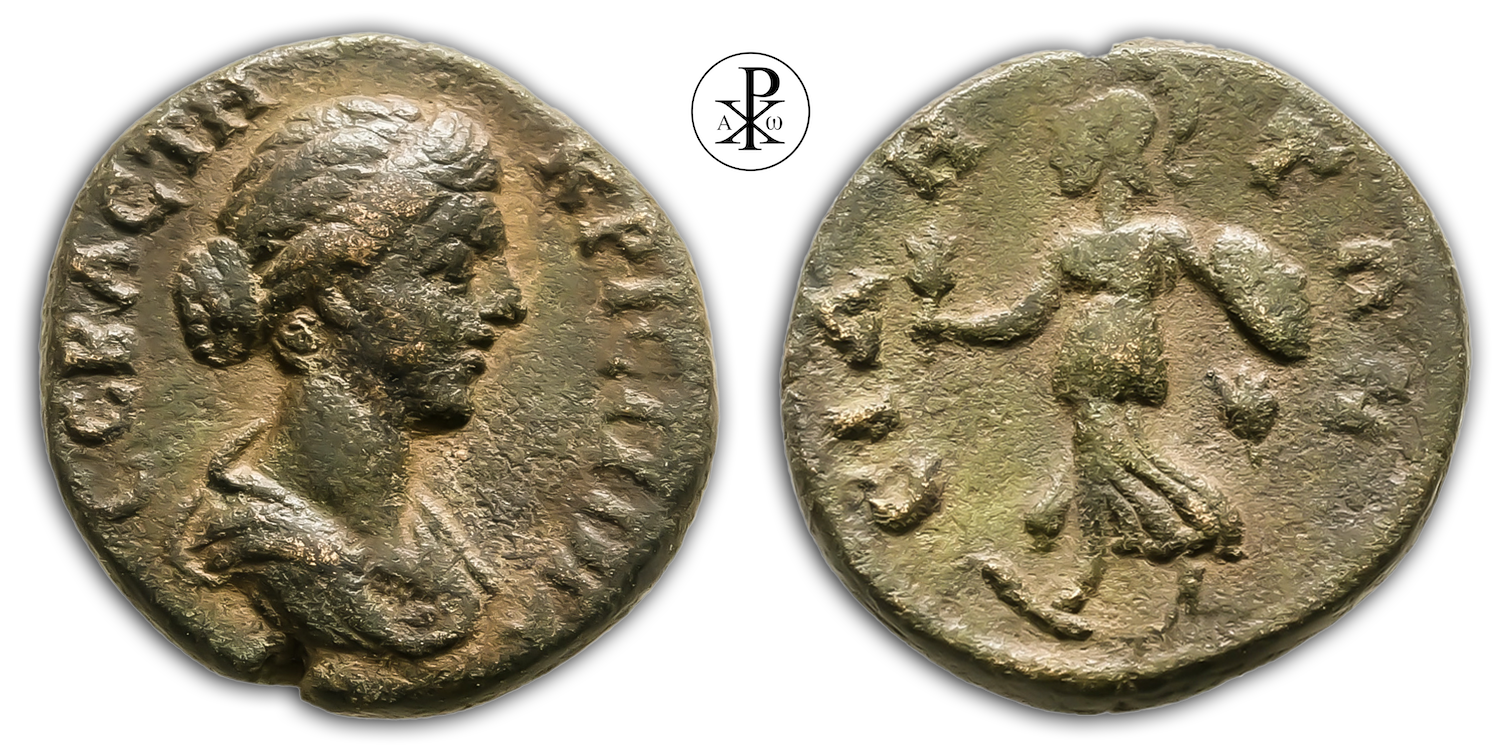Bruttia Crispina
Reign: Marcus Aurelius or Commodus
Mint: Side, Pamphylia
Date: 178/182 AD
Nominal: Bronze
Material: AE
Diameter: 18mm
Weight: 4.58g
Reference: RPC IV.3 8123 (#5 this coin)
Reference: F. Leypold, MÖNG 23 (1983), 27, no. 18
RPC Online: https://rpc.ashmus.ox.ac.uk/coins/4/8123
Rare: Specimens 5 (1 in the core collections)
Provenance: Savoca Numismatik Munich, Germany (Auction 165, Lot 928)
Pedigree: –
Obverse: Draped bust of Crispina, right
Inscription: ΚΡΙϹΠΙΝΑ ϹƐΒΑϹΤΗ
Translation: Krispina Sebaste
Translation: Crispina Augusta
Reverse: Athena advancing, left, holding pomegranate over serpent and shield; to right, pomegranate
Inscription: ϹΙΔΗΤΩΝ
Translation: Sideton
Translation: City of Side
Comment: Side was a city in the ancient landscape of Pamphylia. The city lies about 60 km east of Antalya in southern Turkey. The Manavgat Nehri river flows nearby. Situated on a peninsula, the city was for centuries a prosperous commercial and economic metropolis with an estimated population of up to 40,000. The area of Side covers a rocky peninsula that provided ideal conditions for the alluvial plain of Pamphylia with few opportunities for port facilities. According to mythological tradition, Side was settled from Kyme in the 7th or 6th century BC, the Aeolian coastal city north of Smyrna (Izmir), when many secondary colonies were founded in Asia Minor. However, there was certainly an older settlement on this site. However, the year 1405 BC mentioned by the church historian Eusebios (3rd-4th century) as the date of foundation lacks any historical basis. The name Side means pomegranate; the word is of Anatolian origin. It is a well-known fertility symbol that we encounter on the city’s coins from early times to the Roman imperial period. The Indo-European Sidetic language, which is related to Luwian and is attested on coins and by inscriptions, is probably the original Anatolian language of Pamphylia. Alexander’s conquest incorporated Side and Pamphylia into the Hellenistic world in the eastern Mediterranean. After Alexander’s death, Pamphylia was disputed between the Seleucids and the Ptolemies, and the cities themselves remained independent. This was demonstrated in 223 BC when the young Antiochos III sent an uncle named Achaios to regain Asia Minor, which had fallen into the hands of the king of Pergamon. In the dispute between two cities (Selge, Pednelissos), Achaios asked various cities for help. Aspendos was among those who sent troops, the people of Side refused to reply, „partly out of kindness to Antiochos, but more out of hatred for Aspendos“. The cities acted freely and of their own accord. This changed little in the following decades, which brought more formal changes of ownership – from the Seleucids to Pergamon, from Pergamon to Rome.
In the Roman-Syrian War, 190 BC, Side was the scene of a naval battle between the fleet of Antiochos III, commanding Rome’s old enemy Hannibal, and that of Rhodes, fighting for Rome. Side supported Antiochos. The naval battle ended in a narrow victory for the Rhodians. Soon after, Side switched sides and made an alliance treaty with Rhodes. By fighting on the side of the Romans and their allies, the Sidenets were able to gain a privileged status for their city in the Peace of Apameia. In the siege of Carthage, Side supported Scipio with five warships (147 BC). The importance of the city in Hellenistic times is also underlined by the fact that Antiochos VII was educated in Side and adopted the epithet Sidetes. The Romans, who had been reluctant to send their legions across the Aegean against Antiochos, were not interested in the southern coast of Asia Minor until their attention was drawn here by the growing activity of pirates. Side was heavily involved in piracy around 100 BC, which was becoming more and more rampant. Strabon reports on the so-called „pirate period“, where Side provided markets for the pirates to sell their booty (including human booty) and anchorages. When Pompey put an end to piracy in 67 BC, the citizens hastened to restore its good name by erecting a stately monument and statue of honour to him. Apparently, no punishment was meted out by the Roman Senate. In the Roman imperial period, Side flourished and became wealthy, probably wealthier than most cities in the east, without playing a major historical role. From the 1st to the middle of the 3rd century, an era of great wealth, the city was the seat of the provincial governor. Most of the preserved ruins date from these years, as well as the structures found during the excavations. The large port, which also served as a naval base, and the Roman roads brought a boom in trade, especially with Egypt. The city itself had a considerable merchant fleet. Imported goods went on caravans to central Anatolia, and exports consisted of olive oil, wine and wood. The city also remained a centre of the slave trade. The decline of Roman power in the 3rd century led to a resurgence of piracy. The city was attacked and besieged by Scythian buccaneers from the Black Sea; it resisted successfully. In addition, there were invasions by the Isaurians from the northern mountains. The result was certainly an impoverishment of both the land and the city. Whether Side’s residential area was halved in the 4th century by building an inner city wall along the narrowest part of the peninsula, or whether this only happened 300 years later, cannot be determined beyond doubt.
